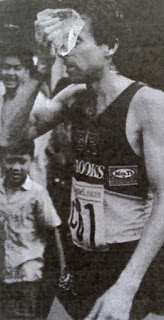 |
| At the finish line, Vietnam War combat photographer Tim Page awaits the winner |
Among the hundreds of competitors were American war
veterans, including disabled vets in the wheelchair division. The government had
welcomed men and women from more than two dozen countries in a competition that
would show the international community that
 |
| Race headquarters at the Saigon Floating Hotel |
By the time he laced up his running shoes on his first visit
to
At a ceremony on the eve of the marathon, American veteran
wheelchair competitors presented wheelchairs to disabled Vietnamese athletes,
and Rodgers approved of the gesture. “I think it’s certainly time for improved
relations and I think most people in the
 |
| Runners passed by the People's Committee Building (City Hall) |
Race day weather was typical for the month of February: dry with an average high of 92F (34C). Rodgers was concerned about the heat and humidity. Plus, he’d recently recovered from an injury. “Extreme caution” was his strategy: “They say the marathon begins at about 20 miles. You got to get to 20 miles and feel at least somewhat capable of finishing.”
Controversy erupted even before the starting gun was fired. As thousands of curious spectators had crowded around the starting line and along the 26 mile long course, a technicality eliminated the three American wheelchair athletes representing the California Paralyzed Veterans Association. Vietnamese race officials had safety concerns about road conditions. The Americans were crushed, but accepted the decision with grace.
However, a hidden factor may also have influenced the
decision. As I reported for CBS News, “There are no Vietnamese wheelchair
athletes which may have reflected on the poor conditions of
Then there was the daring protester who caused a stir outside the riverside hotel serving as race headquarters. A lone Vietnamese man—some say he had a gun—climbed atop a vehicle and hoisted the flag of the old U.S.-backed Saigon Government, threatening anyone who approached.
Communist Vietnam has no tolerance for anti-government protests. Authorities swiftly rushed the man and took him into custody. Several Western photographers and a TV crew were stunned when security officials seized their film.
 |
| Rodgers gets icy relief. Runner's World photo |
The course took the athletes past old Saigon’s most recognizable landmarks: the former French hotel that was known as City Hall during the American War; the abandoned U.S. Embassy (now demolished), which served as the final evacuation point before the fall of South Vietnam; and Tu Do Street, the entertainment quarter where Americans congregated to let off steam.
Hundreds of runners from dozens of countries were
represented. Major media organizations dispatched reporters and photographers
to record one of the biggest events since reunification, 17 years earlier. It
was
The finish line, where onlookers had gathered to watch runners complete the grueling endurance test, was opposite the former Presidential Palace, where communist tanks had crashed through the front gates in 1975, signaling the end of the epic war.
The fastest competitor was a 36 year old British man, Tim
Soutar, who practiced law in
As for Rodgers, he was leading after 22 miles, but wilted under the tortuous humidity. "As I was looking for water after cramps stopped me, a Vietnamese woman on a scooter came alongside me and asked if I was OK. I asked for water and she went into a house and brought me a big glass of water and a huge chunk of ice," Rodgers remembered. "I guzzled the water and walked/jogged to the finish." The massive number of spectators reminded him of the Boston and New York marathons.
Californian Jim Barker was the fastest
 |
| Apocalypse Now bar photo |
One of the more colorful post-race social venues was not officially sanctioned, but enjoyed as a reminder of the Vietnam War: Apocalypse Now bar. Located in a narrow shop house in the former red light district, the small pub took its name—and logo—from Francis Ford Coppola’s 1979 war film, Apocalypse Now.
Athletes joined tourists, journalists, businessmen and locals for an evening of boisterous merrymaking, surrounded by walls painted “night mission” black. Under the ceiling fan, which also served as rotor blades for the Huey helicopter painted on the ceiling, patrons re-hydrated with Tiger Beer and the Vietnamese beer label “33”.
Occasionally a joint was passed between patrons as Hippy
Hippy Shake and other rock tunes blared from the speakers. Two customers
giggled as they imagined a future marathon with a special cyclo division, for
the venerable bicycle taxis that were plentiful on the streets of old
 |
| Human powered cyclos were common in old Saigon, but rare today. |
Nearly 30 years after
Several of his high school classmates had gone to
Rodgers mentioned a veteran who recovered from a helicopter crash, went on to co-found the Greater Boston Track Club and later coached Joan Benoit Samuelson, who would win the marathon gold medal at the LA Olympics in 1984.
 |
| Rodgers sent me a photo of his runner's certificate. |
Rodgers revealed that he initially was not inclined to
participate in the Ho Chi Minh City Marathon. “I thought many people would be
angry here in the
Ultimately, Rodgers decided to run: “I thought, I’ll try to
win the race and I’ll represent the
The former Olympian’s most treasured
“Rick, I’m still a runner . . . of sorts,” Bill told me. “I ran my last marathon at 61, one year after my surgery for prostate cancer.” Formerly ranked #1 in the world, Rodgers still loves going to races, at the age of 73.
 |
| Group photo of vets with Rodgers (right). Photo from Jim Barker (center) |